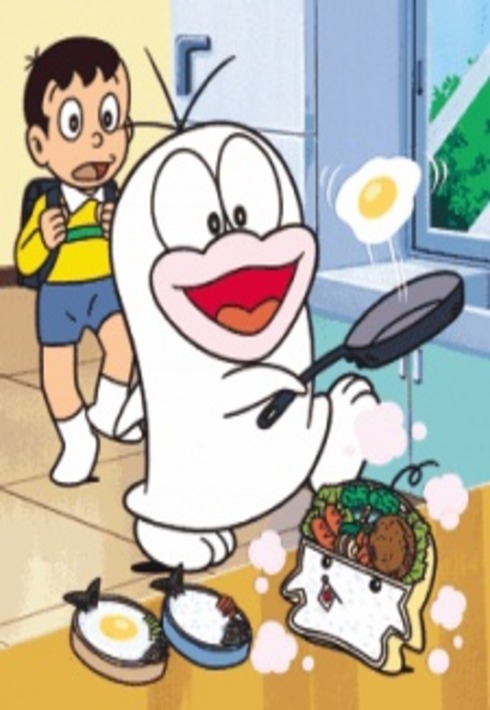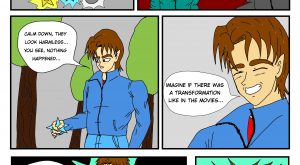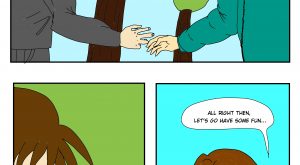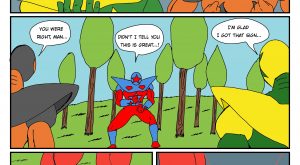Obake no Q-Tarō (manga)
Obake no Q-Tarō (Japanese: オバケのQ太郎, Hepburn: Obake no Kyū-Tarō) is a Japanese manga series by Fujiko Fujio and later Fujiko F. Fujio about the titular obake, Q-Taro, who lives with the Ōhara family. Q-Tarō, also known as “Q-chan” or “Oba-Q”, is a mischief-maker who likes to fly around scaring people and stealing food, though he is deathly afraid of dogs.
The story is usually focused on the antics of Q-Tarō and his friends. The manga was drawn in 1964–1966 by the duo Fujiko Fujio (Hiroshi Fujimoto and Motoo Abiko) and in 1971–1974 by just Hiroshi Fujimoto (as Fujiko F. Fujio). An English manga volume was published in Japan as Q the Spook.
There are three anime series adaptations of Obake no Q-Tarō. The first was shown on the Tokyo Broadcasting System (TBS) in black and white, and ran from 1965 to 1967. The second series, produced in color, ran from 1971 to 1972 on Nippon TV. The third series ran from 1985 to 1987 on TV Asahi. The series was broadcast in the United States in the 1970s as Little Ghost Q-Taro, making it one of only two works by Fujiko F. Fujio to be localized in English.
Characters
- Q-Tarō (Q太郎)
- Voiced by: Machiko Soga (1965), Junko Hori (1971), Fusako Amachi (1985)
- The protagonist of the manga, Q-Tarō has a fear of dogs and cannot transform although he is an obake.
- Shōta Ōhara (大原 正太, Ōhara Shōta)
- Voiced by: Kazue Tagami (1965), Yoshiko Ōta (1971), Katsue Miwa (1985)
- A human friend of Q-tarō, Shōta Ōhara is an elementary school student. Q-Tarō calls him “Shō-chan” (正ちゃん) and Shota calls Q-Tarō “Q-chan” (Qちゃん).
- Shin’ichi Ōhara (大原 伸一, Ōhara Shin’ichi)
- Voiced by: Masako Nozawa (1965), Sumiko Shirakawa (1971), Yū Mizushima (1985)
- Shota’s older brother. He is a middle school student.
- U-ko (U子)
- Voiced by: Hiroko Maruyama (1971), Eiko Masuyama (1985)
- U-ko, a judoka, is Q-Tarō’s girlfriend obake.
- Doronpa (ドロンパ)
- Voiced by: Misae Kita (1965), Yoshiko Yamamoto (1971), Fuyumi Shiraishi (1985)
- Doronpa is an American obake. Q-Tarō tends to have a rivalry towards him due to the fact that U-ko idolizes Doronpa’s intelligence and he likes to annoy Q-Tarō because he is Japanese.
- P-ko (P子)
- Voiced by: Yōko Mizugaki (1965), Kazuko Sawada (1971), Yūko Mita (1985)
- P-ko is Q-Tarō’s younger sister.
- O-jirō (O次郎)
- Voiced by: Makoto Kōsaka→Reiko Katsura (1971), Keiko Yokozawa (1985)
- O-jirō is Q-Tarō’s younger brother. Although he can understand others’ speech, he can only say “bakeratta.” Only Q-Tarō understands what O-jirō says.
- X-zō (X蔵)
- Father of Q-Tarō, P-ko, and O-jirō.
- O-zetto (おZ)
- Mother of Q-Tarō, P-ko, and O-jirō.
- Tsuyoshi Saigō (西郷 強, Saigō Tsuyoshi)
- Voiced by: Kaneta Kimotsuki (1965/1971), Hiroshi Takemura (1985)
- Nickname: Godzilla. A bully in Shota’s class and neighborhood.
- Hakase (ハカセ, “Professor”)
- Voiced by: Mitsuko Aso (1965), Sumiko Shirakawa (1971), Kaneta Kimotsuki (1985), Naoki Tatsuta (1985, stand-in)
- Shota’s smart classmate.
- Kizao Kiza (木佐 キザオ, Kiza Kizao)
- Voiced by: Unknown (1965), Kazuko Sawada (1971), Naoki Tatsuta (1985)
- Shota’s rich classmate who kisses up to Godzilla. His name is also similar to the rich boy in Kaibutsu-kun
- Yoshiko Koizumi (小泉 美子, Koizumi Yoshiko)
- Voiced by: Mariko Tsukai (1965), Michiko Nomura (1971), Sanae Miyuki (1985)
- Shota’s female classmate, always referred to as “Yotchan” (よっちゃん) and U-ko lives with her
- Yukari (ユカリ)
- Voiced by: Unknown (1965), Unknown (1971), Yoko Asagami (1985)
- Shin’ichi’s girlfriend. She is a middle school student, and P-ko lives with her
- Koike (小池)
- Voiced by: Hiroshi Ōtake (1965), Akira Shimada (1971), Shingo Hiromori (1985)
- Ramen chief character, he also appears too as a ramen chief in Doraemon, he appears as a teacher in Ninja Hattori-kun, he appears as a Michio’s father in Ultra B
- Kaminari (神成)
- Voiced by: Reizo Nomoto (1965) and (1971), Shingo Kanemoto (1985)
- Ohara’s neighbor and Doronpa lives with him. And he resembles from Doraemon
Reception and impact
The popularity of the 1965 anime adaptation caused a cultural phenomenon called “Oba-Q boom” (オバQブーム Oba-Kyū būmu), which made the series have an 30% audience rating, high popularity with children and spawn a variety of Toys, songs and clothes, as well a host of imitators. The reason of Q-Tarō’s popularity was that the series was grounded in everyday Japanese life, with Q-Tarō questioning the structure of Japanese society and the comedic situations that occurred because of Q-Tarō misinterpreting it.
Pac-Man creator Toru Iwatani cited the series as inspiration for the designs of the Ghosts in the Pac-Man video game series. In the manga series To Love Ru, the ghost character Shizu Murasame has a fear of dogs as an homage to Little Ghost Q-Taro.
Notes
- The series was written under “Fujiko Fujio” initially. When Fujiko F. Fujio and Fujiko A. Fujio decided to separate, Fujiko F. Fujio took over this series.
| Obake no Q-Tarō | |

Obake no Q-Tarō on the cover of Bessatsu Shōnen Sunday
|
|
| オバケのQ太郎 (Obake no Kyū-Tarō) |
|
|---|---|
| Genre | Comedy |
| Manga | |
| Written by | Fujiko Fujio |
| Published by | Shogakukan |
| Imprint | Tentōmushi Comics |
| Magazine | Weekly Shōnen Sunday Bessatsu Shōnen Sunday Shogakukan Learning Magazine And others Shogakukan children’s magazines |
| Demographic | Shōnen |
| Original run | 1964 – 1966 |
| Volumes | 12 |
| Anime television series | |
| Directed by | Masaaki Osumi |
| Music by | Hiroshi Tsutsui |
| Studio | Tokyo Movie |
| Original network | TBS |
| Original run | August 29, 1965 – June 28, 1967 |
| Episodes | 96 |
| Manga | |
| Shin Obake no Q-Tarō | |
| Written by | Fujiko F. Fujio |
| Published by | Shogakukan |
| Imprint | Tentōmushi Comics |
| Magazine | Shogakukan Learning Magazine And others Shogakukan children’s magazines |
| Demographic | Children |
| Original run | 1971 – 1973 |
| Volumes | 4 |
| Anime television series | |
| Shin Obake no Q-Tarō | |
| Directed by | Tadao Nagahama |
| Produced by | Harutoshi Kawaguchi Kensuke Fujii (Nippon TV) |
| Music by | Naozumi Yamamoto |
| Studio | Tokyo Movie |
| Original network | Nippon TV |
| Original run | September 1, 1971 – December 27, 1972 |
| Episodes | 70 (140 segments) |
| Anime television series | |
| Directed by | Masuji Harada Hiroshi Sasagawa (Chief director) |
| Produced by | Junichi Kimura Yoshiaki Koizumi (TV Asahi) Yoshio Katō Seitarō Kodama (Shin-Ei Animation) (Asatsu-DK) |
| Music by | Shunsuke Kikuchi |
| Studio | Shin-Ei Animation |
| Original network | TV Asahi |
| Original run | April 1, 1985 – March 29, 1987 |
| Episodes | 510 |
| Anime film | |
| Obake no Q-Tarō: Tobidase! Bake Bake Daisakusen | |
| Directed by | Hiroshi Sasagawa |
| Music by | Shunsuke Kikuchi |
| Studio | Shin-Ei Animation |
| Released | March 15, 1986 |
| Runtime | 15 minutes |
| Anime film | |
| Obake no Q-Tarō: Susume! 1/100 Daisakusen | |
| Directed by | Hiroshi Sasagawa |
| Music by | Shunsuke Kikuchi |
| Studio | Shin-Ei Animation |
| Released | March 14, 1987 |
| Runtime | 15 minutes |
| Video games | |
|
|






gate io kimlik doğrulama
I am a website designer. Recently, I am designing a website template about gate.io. The boss’s requirements are very strange, which makes me very difficult. I have consulted many websites, and later I discovered your blog, which is the style I hope to need. thank you very much. Would you allow me to use your blog style as a reference? thank you!